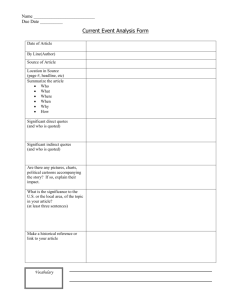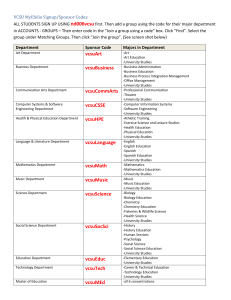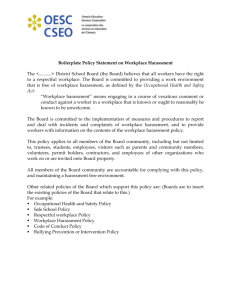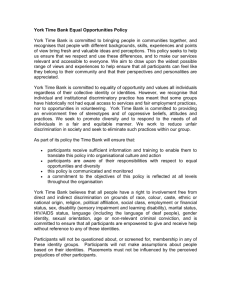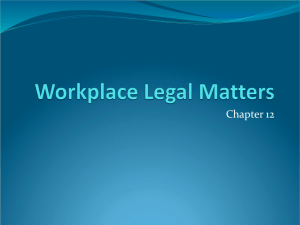Gender Biased Perceptions At Work Places
advertisement
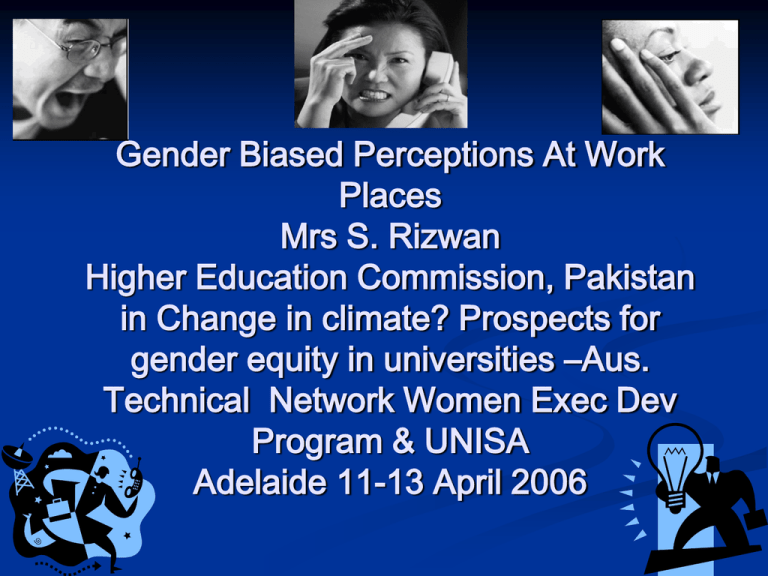
Gender Biased Perceptions At Work Places Mrs S. Rizwan Higher Education Commission, Pakistan in Change in climate? Prospects for gender equity in universities –Aus. Technical Network Women Exec Dev Program & UNISA Adelaide 11-13 April 2006 Introduction Importance of the study Literature Review Need For the study Importance This research is unique because it incorporates men’s perspectives, insights, and understandings alongside those of women talking about the different or shared realities of their work-life relationships. The assumption is that gaining insight into how professionals perceive gender relations in the workplace can help us to more fully understand what is involved currently in organizations and can improve efforts to end systemic gender-based discrimination. Not only such improvements will help women achieve equality, but also they will help men feel more comfortable working with women. Literature Review The main theme of this research was taken from the American Public Administration Review, which was published in 1999 Some of the questions are based upon the “Women Workplace Culture Questionnaire” Policy Regarding Women By Ministry of Women , Government of Pakistan The statistics are quoted from data available by the statistics department, Higher Education Commission, Government of Pakistan, and statistical Bureau, GOP. Articles & Journals reviewed…… American Public Administration Review, (1999) The Impact of Male Work Environment & Organizational policies on Women’s Experiences of Sexual Harassment by James E. Gruber, Gender & Society, Vol.12,No.3 (June 1998),301-320 Communication & Education by M.M. Lewis, British Journal of Educational Studies, Vol.1.No.1(Nov.1952), 28-32 Work Satisfaction & Age: Some Evidence for the “Job Change” Hypothesis by James D.Wright, Richard F.Hamilton Social Forces, Vol.56, No.4 (June,1978), 1140-1158 Women At Work, Aroura By DAWN publications, Paksitan. Need of the study/ Usage The knowledge generated by this research will be useful to 1. 2. 3. Administrators and Managers who want to understand the factors that impede women’s advancement; Researchers working to identify the factors that perpetuate gender inequality in organizations; Policy/Decision makers who want to initiate a process for constructive change. Method Research Tool Sample Extension of the Sample Size Research Tool Face to face interviews Tape Recorded Video Recorded Written Comments Sample Introduction Why Only Public Sector Organizations? Sample Size Sample Characteristics This study explored how professional men and women in “public-sector” workplaces perceive the relationship between gender and their ‘lived’ work experiences. The data are based on interviews with University Teachers Public Administrators, conducted initially from April-Sep 2005 after wards extended the sample size from Oct-Mar 2006 Why Only Public Sector Organizations? The gender mix in public sector universities and government organizations differ from private workplace arenas; both are heavily male-dominated and are assumed to be typical of workplaces in terms of gender relations, narrow-mindedness, and stereotype. Sample size The participants included 60 men and women Women (32) 2 Vice Chancellors 20 Faculty 10 Public Administrator Men (28) 8 Vice Chancellors 10 Faculty 10 Public Administrator Sample Characteristics Age Group 30- 60 Profession 20 faculty members 10 Vice Chancellors from public sector universities from Major universities situated in four provinces of Pakistan 20 of the participants were public service administrators and bureaucrats from government agencies (Ministry of Planning, Ministry of Finance etc.) selected on Quota system coming from all over Pakistan. Phases 1st Phase Brain Storming Out comes 2nd Phase Interview guidelines 3rd Phase Conducting Face to face Interviews Conducting Second interviews 4th Phase Compiling Results Phase 1 Brain Storming Outcomes Themes Extract guidelines for interviews Phase 2 Interview Guide lines Developed Questions Questions 1. 2. 3. 4. 5. 6. 7. 8. 9. 10. 11. Men and women experience different gender issues in their workplace interactions? How women’s place in the workforce, their economic status, and the increased competition affects men and women as a whole? Men’s and women’s interactions in organizations affect systemic discrimination? Do you agree? How cultural values and overt practices can lead to inequality, harassment, and discrimination (whether it is based on sex, age, race, or physical ability). Do you think that women have fewer opportunities than men for professional development at a workplace? Do you think that woman receive more unfair judgment of their work performance than men. Do you think that man receive more organizational support and trust than women. In your situation: Do you think that the way you have been addressed at work by management and superiors has been influenced by a negative attitude towards you because you are women. Do you think that it is more difficult for women than men to be them selves at work? Do you think that men have greater employment security than women? Do you think that women contributions are perceived differently, that is do men fail to pay attention to what women say at meetings? Continued …. (Questions) 12. 13. 14. 15. 16. 17. 18. 19. 20. 21. 22. Do you think that women had to be more accomplished in their work than men in order to be promoted? Do you think that women receive enough organizational support in order to mange their professional work and their domestic responsibilities? How do you perceive your self and how others perceive you in your workplace? Which gender is more emotional and aggressive in your work place. which gender is more powerful in being heard, doing work and getting things done? Have you ever faced Harassment or any tension working with cross gender? Generally speaking if you experience a particular difficulty, have you some where or somebody to speak openly about it will? ask if you have ever thought about leaving your job because of gender related problems. Do you think that your organization or people at the top hierarchy have different standards to judge the qualification of men and women? Do you prefer to work in team with cross gender? Or the same gender? Which gender seems to be more comfortable to deal with? Phase 3 Conducting face to face Interviews Conducting second interviews Phase 4 Compiling Results Findings Findings The findings revealed the following major issues: Identity & self-efficacy Emotion and Anger Power and powerlessness Harassment &Tension Discrimination Trust Communication Shared Experience 1. Identity & Self Efficacy (means self judgment based on socialization process by which individuals incorporate assumptions, perceptions, stereotypes and misperceptions and make judgments about them selves based on the way they perceive other judge them.) Quoted Statement….. “When ever assigning any major task, my senior males) always ask each other, ‘Is this going to be important to her? Do we need to include her... because she’ll make things miserable for us If she is excluded?” -University professor When ever there is an issue of decision making they( male peers) use to exclude me or ignore my comments..... and whenever there is an issue of taking responsibility they unilaterally make me responsible..., what a justice they do!....... -Public Administrators Quoted Statements….. “[I’m seen as] responsive, I always get things done... and solve any sort of work related issues. I’m perceived as very strong, independent and competent. .. easy to work with… But men in our society….you know...are perhaps threatened by it.” -Public Administrator 2. Emotion and Anger (Emotionality involves both the expression of feelings and intensity of feelings provoked). Quoted Statement…… “I suspect male colleagues . . . perceive me as . . . overly emotional... To be emotional is considered unacceptable by [them]. ... I’ve been told. .. by one male colleague that I risk losing my credibility on the faculty. He...said...one of my female colleagues already has lost her credibility because she has dared to be emotional . . . about professional matters. . . . You start feeling you can’t win.” University Professor Quoted Statements….. “I think all the females in my department see me as distant and manipulative. . . [and] as somebody who has to be handled. . . who needs to be approached gently....[They] don’t trust me very much.” - University Professor 3. Power and Powerlessness (Which gender is more powerful? Male or female) Quoted Statements….. “I have (female] colleagues who won’t stand up for their rights [or] speak up in meetings when it’s necessary... You’ve got to establish that ‘I deserve to be there. -University professor “I feel today women are much more powerful than men at work places as they are much louder and bold than ever before. One of the dilemmas and conflicts, seems to be that smart women…tend to threaten their male peers.” -University Professor 4. Harassment &Tension (With reference to communicationcross gender Quoted Statements…. “That conversation [provoked me to think]. . .Am I more comfortable doing business with a woman because I have a sense of power or superiority, whether it’s there or a perception of that, or is there. . . a general attraction to the opposite sex that makes me comfortable in that kind of social relations,.” -Administrator “I am afraid of working in close doors with my peers!....... because you never know who turns out to be of which nature? Even a wrong eye-gesture can effect your work….. that is why I try to finish my work in time and avoid staying back for long hours after the office timings are over.” -Public Administrator 5. Discrimination (Different standards to judge the qualification of men and women) Quoted Statements…. “When I was hired...I was assured, ‘We want you to know that we didn’t select you because you were a woman but because you were qualified. We didn’t have to hire a woman this time, and we hired you anyhow.’ Still, everyday.., there was always that question...Did she get hired because she was a woman or... the best qualified for the job?” -University Professor ‘My wife’ is a faculty member...who1 can’t get promoted. The question of why I could get promoted with no questions, with probably less credentials. . . and she [with] more credentials. . . can’t get promoted, bothers me. . . . In that sense, I think the academic world is much harder. The glass ceiling is much more difficult to break.” -University Professor Quoted Statements….. “I want to be accepted... in terms of my ability to perform, but I am [not accepted] into the social climate of the organization. I’m not one of the men.” -Public Administrator 6. Trust (Lack of trust between men and women) The issue of trust involves a lack of trust between men and women and risk aversion in talking about gender in organizations. As noted earlier, besides change in attitude towards females ‘ still women feel that they are just treated as symbol of attraction for marketing purposes they are good but for decision making they are not trust worthy at all. Women tended to link trust and sexuality; that is, they believe that sexuality, as well as potential threats of sexual harassment, affects trust and bonding within an organization. Quoted Statements…. “Bonding is slower between men and women, Men feel that women are not trust worthy so they shouldn’t held responsible for any thing important as they back off at the eleventh hour always. .... Because [of this], it can take a long time to get trust.” -Public Administrator “Trust is a double edge sword.” -University Professor 7. Communication (Importance of listening and need to understand and to be sensitive to others different perspectives) Quoted Statements….. “The biggest… issue is.... communication. What I might be saying to my male counterpart must not be what he understands at all and vice versa.” -University Professor “I’m constantly interrupted at faculty meetings. I can say something and it’s totally ignored, and the next minute somebody else will say it and it’s a great idea that never gets attributed back to me... .1 often.. . have to say, “I’m sorry, I’m not finished yet.” I perceive that as meaning that I’m pretty much irrelevant. . a marginal part of the department. “ -University Professor Quoted Statements….. “Its hard for women to work in closed doors with men at workplaces, as they have to face lots of rumors from other people around, specially when they are with their seniors,….. You see in our society if a senior or even a peer from the opposite sex supports some one every body talks about them having a wrong relationship so how can we communicate freely and fearlessly?.......” -University Asst. Professor 8. Shared Experience (Men & Women’s shared experience, sense of invisibility and isolation). Shared experiences means the common experiences that men & women expressed in their work lives. The majority of women were particularly aware of common, everyday patterns of distancing and avoidance in their organizations. Some described their shared sense of isolation and invisibility. Quoted Statements….. “I identified with what the other women were saying. . . . that we’ll say something and it’ll be invisible. People will just go right past what we said, unless we say it again.” -University professor Conclusion The analysis shows that the following five statements are likely true. Men and women experience issues and interactions differently in the workplace. Men and women experience different gender issues in their workplace interactions. Men and women experience the same interactions differently in their workplace. These emerging issues suggest different meanings for male and female public administration professionals. Men’s and women’s interactions in organizations affect systemic discrimination. By listening to the men & women, the following points have emerged; Both men & women have expressed frustration with visible & invisible signs of bias, discrimination & inequality. Both genders have emphasized on the factor of listening which ultimately will help for more communication and healthier work life relations. The study also provides detailed explanation of why men are uncomfortable choosing women as a superior and why women fear about talking their experiences in public. Women feels that most of men (especially their peers) use to ignore their capabilities and are afraid that women will over shadow them in the workplaces and get promoted. The degree to which child hood and early adulthood socialization related to gender remains conscious and plays out in later work place experiences. Women regardless of being much confident than ever still they don’t trust men at workplaces and avoid to work in close doors and stay for longer time periods. Recommendations Make conscious efforts to improve communication & social relationships within organizations. Encourage group projects and assignments where male and female representation is equal. Women should be brave and speak up and confront disrespectful and unprofessional attitude and behaviors. High level managers especially males should make sure that every body is heard and equally given importance regardless of gender. Ensure equity in assignments, mentoring and training opportunities. Support & reward a collegial environment. Equal employment opportunities to females should be supported especially at the decision making positions. Last Word….. While this research study’s goal was to elucidate themes, not to test hypotheses, one guiding hypothesis coming from this research is that changing gender inequalities in the management of public organizations will require examination not only of those aspects of interpersonal relations that can develop and maintain the glass ceiling, but also those that can facilitate a more cooperative and constructive working environment. University Statistics University Vice Chancellors 120 100 80 Male/ Female Female only 60 40 20 0 194766 19872006 Year Public/ Private Universitie s for Female Universities for (Male/ Female) Degree Awarding Institutions for Female Degree Awarding Institutions for (Male/Femal e) 1947-66 0 7 0 2 1967-86 0 21 0 3 1987-2006 5 85 1 26 Percentage of Population between Age Group 18 to 26 years, Enrolled at University Campus for Higher Education Est. Pop Age Group 18 to 26 yrs. (Million) * Male Female 2001-02 11.98 2002-03 2003-04 Year Enrollment Including Ph.D. (Million) Total Male Female 11.74 23.72 0.175 0.102 12.23 11.96 24.19 0.204 12.26 12.63 24.9 0.245 Total Enrollment at University Campus (%) Male Female 0.276 1.46 0.87 1.16 0.128 0.332 1.67 1.07 1.37 0.179 0.423 1.99 1.41 1.7 * Source: Economic Survey of Pakistan 2004-05 and Pakistan Statistical Year Book 2002-03 Total Full Time Faculty Members classified by their Highest Qualification during 2003-04 Sector Distance Learning Bache Master Master M. Phil. Ph.D. lors s (H) Total 9 110 0 22 41 182 Public 1059 4525 1319 1019 2549 10471 Private 1151 1480 508 284 540 3963 Overall 2219 6115 1827 1325 3130 14616 Faculty Number of Full and Part Time Faculty members by Public & Private Sector during 2003-04. Sector Distance Learning Full Time Part Time Total 182 17620 17802 Public 10471 2975 13446 Private 3963 2217 6180 Overall 14616 22812 37428 Gender wise Enrollment at Public and Private Sector Universities/DAI (including Constituent Colleges) during the Period 2001-04 Sector 2001-02 Male Female 2002-03 2003-04 Male Female Male Female Public 141569 90832 162407 114077 199553 162575 Private 32935 10938 41272 13989 44960 16148 174504 101770 203679 128066 244513 178723 Total Gender Wise Enrollment at Universities/DAI (including Constituent Colleges) by Area during the Period 2001-04 Area 2001-02 Male Federal * 2002-03 Female Male 2003-04 Female Male Female 62184 48160 75876 62795 97927 97893 AJK 1111 516 1527 671 1676 708 Balochis tan 3425 959 3670 1085 4421 1360 NWFP 22811 7183 25310 7976 27546 9134 Punjab 40364 21218 48535 29088 62224 40557 Sindh 44609 23734 48561 26451 50719 29071 Total 174504 101770 203679 128066 244513 178723 * = Including Distance Learning What we have accomplished: Comparison of percentage of women at faculty ranks 1985-2005 50% 45% 40% 35% 30% 25% 20% 15% 10% 5% 0% 1985 1989 1993 Professor Assistant Professor 1997 2001 Associate Professor Instructor/Lecturer 2005 Thank You!
